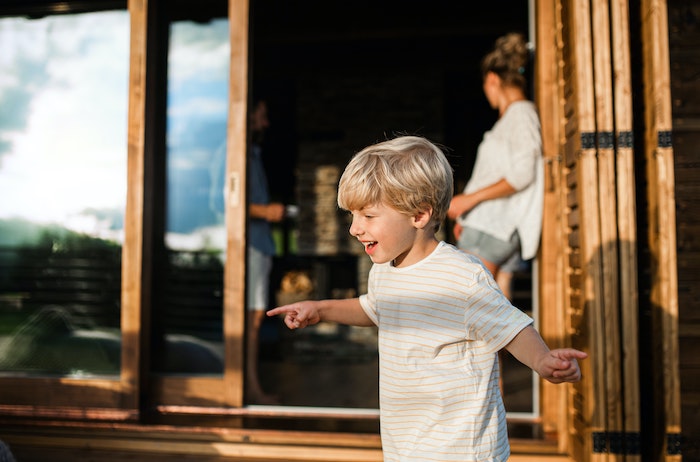Why are Child Door Locks Important?
According to the Centers for Disease Control and Prevention (CDC), unintentional injuries are the leading cause of death for children in the United States.
Many of these injuries occur in the home, and a significant number of them are caused by falls and accidents with doors. Children are naturally curious, and they can easily wander into areas that are potentially dangerous for them, such as garages, basements, or rooms with cleaning supplies.
Enter child door locks. These special locks are a cost-effective and practical way to ensure your child’s safety and give you some peace of mind around the house.
Child door locks provide a simple solution to prevent these types of accidents from happening. They are designed to keep doors securely closed, so your child cannot open them and access areas of the home that may be unsafe.
Types of Child Door Locks
There are different types of child door locks available on the market, and each has its own set of advantages and disadvantages. Here are some of the most popular types of child door locks:
- Lever Handle Locks – These locks are easy to install and use. They attach to the existing door handle and prevent the lever from being pushed down, so the door cannot be opened. Lever handle locks are suitable for doors with lever handles, such as interior doors and closet doors.
- Door Knob Covers – These covers fit over the existing door knob and prevent your child from turning the knob and opening the door. They are easy to install and remove and can be used on most types of door knobs.
- Deadbolt Locks – Deadbolt locks provide an extra level of security for exterior doors. They are more difficult to install and use than lever handle locks and door knob covers, but they are more secure.
- Sliding Door Locks – These locks attach to the sliding door and prevent it from being opened. They are suitable for sliding glass doors and can also be used on windows.
How to Choose the Right Child Door Locks
Choosing the right child door locks depends on the type of door you have and your specific needs. Here are some factors to consider when selecting child door locks:
- Door Type – Different types of doors require different types of locks. For example, lever handle locks are suitable for interior doors, while deadbolt locks are necessary for exterior doors.
- Ease of Use – Choose a lock that is easy for you to install and use, but difficult for your child to figure out. You don’t want a lock that is too complicated or time-consuming to use, as this can defeat the purpose of having one.
- Durability – Look for locks that are made of durable materials and can withstand regular use. You want a lock that will last for a long time and provide reliable protection.
- Price – Child door locks come in different price ranges, so choose one that fits your budget. Keep in mind that the most expensive lock may not necessarily be the best one for you.
Installation and Use of Child Door Locks
Installing child door locks is a straightforward process, and most locks come with clear instructions and all the necessary hardware.
Always check the manufacturer’s suggested installation instructions and for any potential defects in the product. It’s probably not a bad idea to do a quick search for any potential baby product recalls.
Here are some general steps to follow when installing a child door lock:
- Determine the type of lock you need based on your door type and your specific needs. Read and follow the manufacturer’s instructions carefully before installing the lock.
- Use the necessary tools to install the lock, such as screwdrivers, drills, or hammers.
- Test the lock after installation to make sure it is working correctly and your child cannot open the door.
- Educate your child about the importance of the lock and make sure they understand that certain areas of the home are off-limits.
- Regularly check the lock to make sure it is still working correctly and replace it if it becomes damaged or worn out.
Child Door Locks Best Practices
Child door locks are an essential part of child safety, but they are not foolproof. Here are some best practices to follow when using child door locks:
- Use locks on all doors that lead to potentially dangerous areas, such as garages, basements, and rooms with cleaning supplies.
- Teach your child about the dangers of certain areas of the home and why they are off-limits.
- Regularly check the locks to make sure they are working correctly and your child cannot open the door.
- Make sure your child cannot reach the door lock or the key to the lock.
Don’t rely solely on child door locks to keep your child safe. As parents, we all know kids get bumps and bruises but there are a number of other safety measures you can implement around your home like baby gates and cabinet locks that can help to prevent accidents from happening.
Conclusion
Child door locks are a crucial part of child safety and can prevent accidents from happening in the home. They are easy to install, affordable, and can provide you with peace of mind knowing that your child is safe and secure.
When choosing child door locks, consider the type of door you have, the ease of use, durability, and price. Follow the manufacturer’s instructions carefully when installing the lock and regularly check to make sure it is working correctly.
Remember, child door locks are not foolproof, so use other safety measures in conjunction with locks to keep your child safe.
Links to sources and data that may be helpful for further reading:
Centers for Disease Control and Prevention (CDC) – “Unintentional Injury”: https://www.cdc.gov/nchs/fastats/accidental-injury.html
American Academy of Pediatrics – “Preventing Injuries From Doors and Gates”: https://www.healthychildren.org/English/safety-prevention/at-home/Pages/Preventing-Injuries-from-Doors-and-Gates.aspx
National Safety Council – “Injury Facts”: https://injuryfacts.nsc.org/all-injuries/preventable-death-overview/odds-of-dying/odds-of-dying-chart/
Consumer Product Safety Commission (CPSC) – “Childproofing Your Home”: https://www.cpsc.gov/Safety-Education/Safety-Education-Centers/Childproofing-Your-Home
Safe Kids Worldwide – “Child Safety Fact Sheet”: https://www.safekids.org/sites/default/files/documents/ResearchReports/skw_child_safety_fact_sheet_2015.pdf
Recall information:




